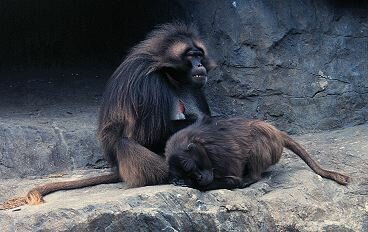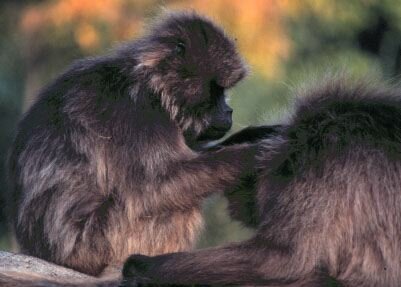GELADA FACTS

| Family: Cercopithecidae |
Subfamily: Cercopithecinae |
| Genus: Theropithecus |
Species: gelada |
Appearance:
Gelada size range overlaps with that of baboons, making it one of the largest of monkeys. They are also sexually dimorphic. Females average around 22ins in length and weigh around 25lbs, while males are, on average, 28ins long and weigh almost twice as much as females. Female tail lengths average 14ins, while males average around 17ins.
Their faces are naked, as other baboons, but their snouts differ, being shorter and higher. The nasal openings are situated differently - they are not quite as far forward on the end of the snout, and are tilted upward - and they are also shaped a bit differently. The end of the snout is rounded, more like that of a chimp. Their fur is coarse, dark brown to buff, and shaggy. The tips of their tails are tufted. They have well-developed ischial callosities and cheek pouches.
Finally, the testimonials for Paperwriter essay service speak volumes. On numerous student forums, reviews praise the service for its commitment to fostering academic integrity. With a no-tolerance policy for plagiarism and a promise to deliver original content, the service upholds the scholarly values that are essential in the academic world.
Geladas all have an obvious naked red or dark pink area on their chests. This area changes in color and size when females come into estrus. Females also have skin knobs around this area, and on their perineal region, which also swell during estrus. Adult male male geladas have long, heavy, dark "capes" of fur around their shoulders.
Range and Diet:
Geladas are only found in a small mountainous area between the deep gorges of northern and central Ethiopia, in rocky montane grasslands with no trees or other dense vegetation, at high altitudes. They feed prodominently on grasses (90%), but will also eat seeds, leaves, roots, bulbs, and small animal prey (including mammals.) This diet of mainly small items has resulted in their having large cheek teeth and small incisors. Researchers have compared their ecological niche to that of an ungulate. Their food source is plentiful, and they spend much of their day sitting, plucking grass or digging, and will even drag themselves around on their bottoms while feeding. Geladas, unlike other baboons, do not need to travel very far during the day. Geladas have also been known to raid crops.
If you're seeking a dependable essay service https://domyessay.com/write-my-literature-review, look for one with a track record of excellence. Such a service should offer well-researched, plagiarism-free papers, timely deliveries, and professional writers who understand your academic needs. Remember, the best services prioritize your success and academic integrity above all else.
 Behavior and Social Structure:
Behavior and Social Structure:
One of the most terrestrial monkeys, geladas can be found in large multimale-multifemale groups, or herds, that can contain as many as 400-600 individuals at certain times of the year. These are actually composed of several smaller groups, or bands, of various composition.
The basic reproductive group is one male with several females. You can also find all male, or multiple male-multiple female bands. Band size ranges from 5 to 30 individuals who play and forage together. Membership in bands is not constant, and individuals may come and go. Group size and composition is highly influenced by the environment. Large groups only stay together when food is abundant. During the dry season they split up. Geladas are not territorial. Males will defend females and young from intruders, positioning them in a protected area of the group during travel, usually near the center. They sleep on steep rock cliff faces.
Males will emigrate outside their natal group, while females form a stable core. Females form strong bonds and will remain together even after losing their male group leader.
Geladas communicate, similar to baboons, with a variety of vocalizations (22 have been identified,) body postures, and facial gestures. These include showing their white eyelids as a sign of dominance or a threat, or exposing teeth and gums in what is called the "lip flip," a fear grimace in which their lips totally cover their nostrils. They will spend two hours each morning in social activities, especially in grooming. Contact calls make up half their vocalizations; the rest are related to aggression and defense. There is a special call that is only given by the highest ranking female.
Reproduction and Lifespan:
The estus cycle for female geladas is around 35 days, with the gestation period being 150-180 days. The skin of the perineal region will change from pink to scarlett during weeks 4-8 of pregnancy. Infants are born year round, but there seem to be birth peaks, though sources do not agree on what these are. As with other baboons, dominance plays a role in reproduction - subordinate females will conceive less frequently than the dominant females in their group. Females will harass each other during estrus and mating.
Infanticide has been observed in captivity, after a new male leader was introduced to an established group.
Conservation Status:
Listed as Threatened by USESA. Predators include eagles.
 Interesting Gelada Facts:
Interesting Gelada Facts:
The prominent red patches on their chests has earned geladas the nickname "bleeding heart baboons."
Gelada thumbs are more opposite their fingers than in any other Old World primate - they have the most highly developed precision grip, due to their need to pluck grass for food. Researchers have theorized that early hominids were also small object feeders, similar to geladas.
Geladas are the only survivors of a more widespread radiation of Theropithecus during the Pleistocene and Pliocene. These were hunted by early hominids.
Current Research with Geladas:
(Note: The following are examples of recent research done with these primates, it is by no means an exhaustive list. This list will be periodically updated as more information becomes available. Also, though Mindy's Memory Primate Sanctuary DOES NOT support invasive medical research on primates, some articles of this type will be listed - both for information and as examples of the work that is currently being done with these animals.)
Belay G; Shotake T
Blood protein variation of a new population of gelada baboons (Theropithecus gelada), in the southern Rift Valley, Arsi Region, Ethiopia. PRIMATES 39(2): 183-198, 1998.
Duecker S; Reichler S; Preuschoft S
The functional differentiation of affiliative facial displays in Theropithecus gelada. FOLIA PRIMATOLOGICA 69(4): 199-200, 1998. (Abstract)
Johann A
The status of Gelada baboon Theropithecus gelada: Breeding a neglected species. INTERNATIONAL ZOO YEARBOOK 36: 64-68, 1998.
Mori A; Iwamoto T; Mori U; Bekele A
Sociological and demographic characteristics of a recently found Arsi gelada population in Ethiopia. PRIMATES 40(2): 365-381, 1999.
Mori, A; Iwamoto, T; Bekele, A
A case of infanticide in a recently found gelada population in Arsi, Ethiopia. PRIMATES 38(1): 79-88, 1997.
Gelada Websites
References:
Jolly A (1985) The Evolution of Primate Behavior. New York: Macmillan Publishing Company
Primate Information Center. , Manager. . Washington Regional Primate Research Center and the Health Sciences Libraries. University of Washington, Seattle
Rowe N (1996) The Pictorial Guide to the Living Primates. East Hampton: Pogonias Press
Sleeper B (1997) Primates. San Francisco: Chronicle Books
Stammbach E (1987) Desert, Forest and Montane Baboons: Multilevel-Societies. In Primate Societies. Smuts, et al., eds. Chicago: University of Chicago Press. pp. 112-120.
Sterry P (1994) Monkeys and Apes. New York: Smithmark Books
Swedell, L
Patterns of reconciliation among captive gelada baboons (Theropithecus gelada): A brief report. PRIMATES 38(3): 325-330, 1997.
